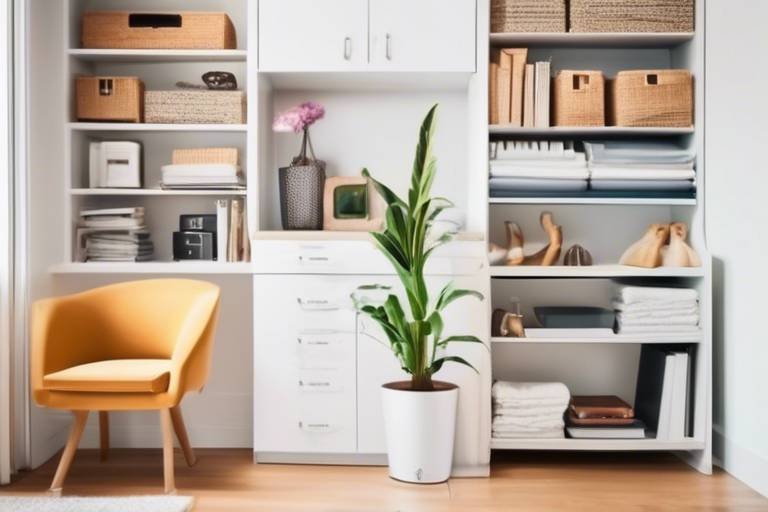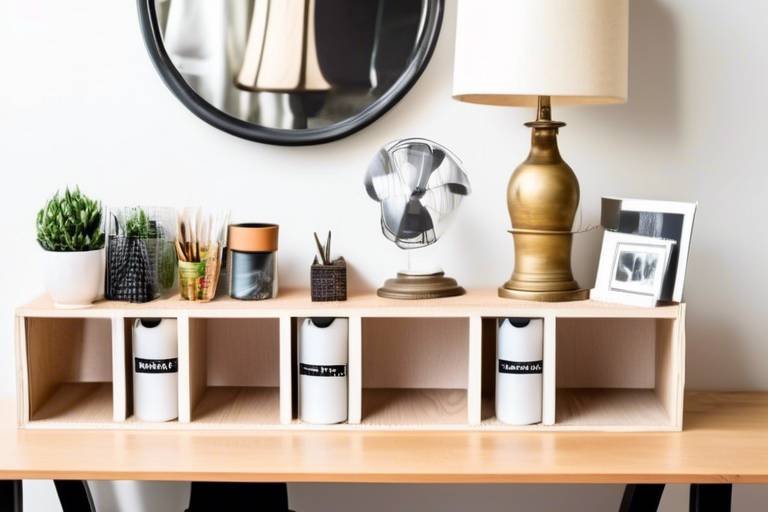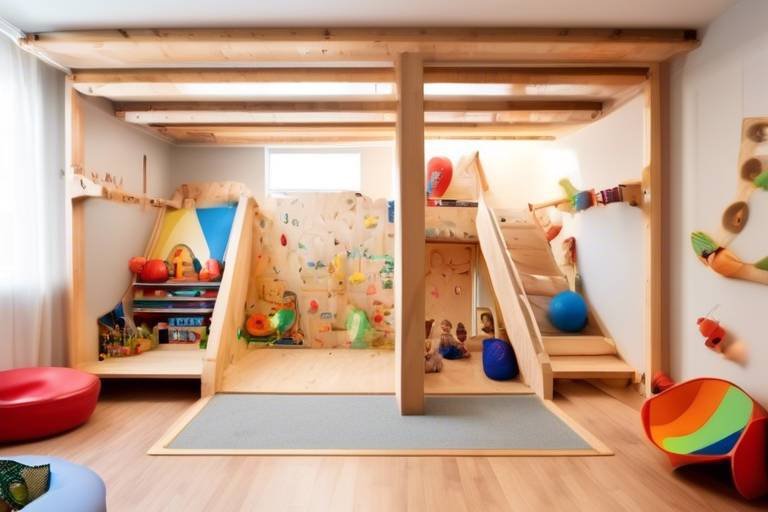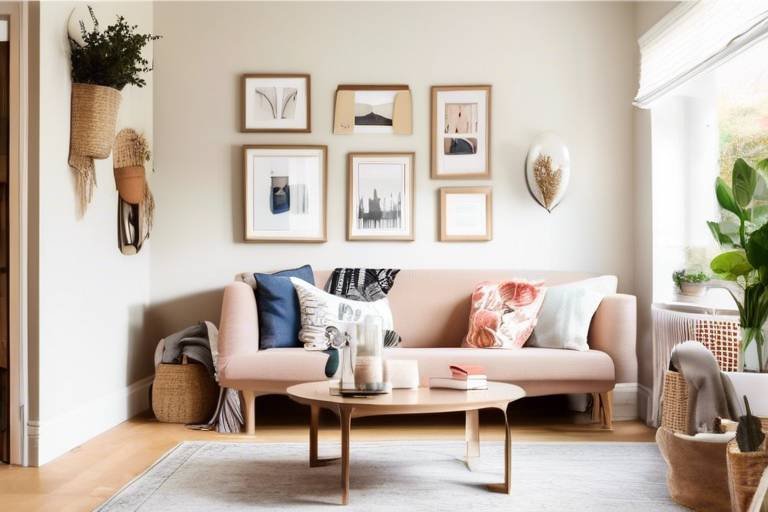How to Create a Zen Space in Your Home
Creating a Zen space in your home is not just about aesthetics; it's about cultivating a serene atmosphere that promotes peace and mindfulness. Imagine stepping into a room that instantly calms your mind, where every element contributes to a sense of tranquility. Whether you're looking to transform an entire room or just a cozy corner, the key lies in understanding the principles of Zen philosophy and applying them to your personal space. This article will guide you through essential tips and strategies to achieve a true Zen atmosphere that resonates with your inner self.
At its core, Zen philosophy emphasizes simplicity, mindfulness, and balance. These principles are crucial for creating a serene space in your home. Think of Zen as a gentle breeze that sweeps through your life, removing clutter and distractions, allowing you to focus on what truly matters. By embracing simplicity, you can eliminate the chaos that often crowds our minds and spaces. Mindfulness encourages us to be present, to appreciate the beauty in our surroundings, and to engage with our environment intentionally. Lastly, balance is about finding harmony between elements, ensuring that no single aspect overwhelms the others. When these principles intertwine, they create a sanctuary where you can unwind and recharge.
Selecting the perfect area in your home for your Zen space is pivotal. Consider factors like natural light, noise levels, and personal comfort. A quiet corner by a window can be a great choice, allowing sunlight to pour in and energize the space. Alternatively, a cozy nook away from the hustle and bustle might serve as your ideal retreat. The location should resonate with you, inviting you to spend time there and engage in activities that promote relaxation, such as reading, meditating, or simply enjoying a cup of tea.
Natural light is essential for enhancing the atmosphere of your Zen space. It not only improves your mood but also connects you with the outside world. A well-ventilated area ensures that fresh air circulates, which can significantly impact your mental clarity and overall well-being. Consider the following when designing your space:
- Position furniture to maximize light exposure.
- Open windows regularly to let in fresh air.
- Incorporate mirrors to reflect natural light and create a sense of spaciousness.
When it comes to window treatments, you want options that allow light while maintaining privacy. Sheer curtains can gently diffuse sunlight, creating a soft glow in the room. Bamboo shades offer a natural touch, bringing in light while providing a sense of enclosure. Choose materials that resonate with your Zen aesthetic, opting for muted colors and organic textures that promote a calming vibe.
Improving air quality is fundamental to maintaining a healthy Zen environment. Indoor plants not only beautify your space but also purify the air, making it fresher and more inviting. Consider incorporating plants like snake plants, peace lilies, or spider plants, which are known for their air-purifying qualities. Additionally, using an air purifier can enhance your space, ensuring that you breathe easy and feel rejuvenated.
Decluttering is vital for reducing stress and creating a more peaceful and organized Zen space. A cluttered environment can lead to a cluttered mind, making it difficult to relax. Start by assessing your belongings and ask yourself: Do I need this? Does it bring me joy? If the answer is no, it might be time to let it go. Organizing your space can be a therapeutic process, allowing you to reconnect with your belongings and create a more harmonious environment.
Integrating natural materials and elements into your Zen space promotes a connection with nature, enhancing the overall calming effect. Consider using materials like wood, stone, and natural fibers in your decor. These elements not only add texture but also evoke a sense of grounding and stability. When you surround yourself with nature, you invite tranquility into your life.
Selecting and arranging indoor plants can transform your space into a refreshing oasis. Plants not only beautify your environment but also contribute to your mental well-being. Arrange them thoughtfully, placing taller plants in corners and smaller ones on shelves or tables. This layering creates depth and interest while fostering a sense of calm. Remember to care for your plants, as their health will reflect on your space's overall energy.
Choosing colors and textures inspired by nature can create a soothing palette that fosters relaxation. Think of soft greens, earthy browns, and gentle blues that mimic the outdoors. Fabrics like cotton, linen, and jute can add warmth and comfort, making your Zen space inviting. When you walk into a room filled with these natural hues and textures, it feels like a breath of fresh air, instantly calming your senses.
Q: What is the best way to start creating a Zen space?
A: Begin by selecting a quiet area in your home and decluttering it. Incorporate natural elements and choose calming colors to set the tone.
Q: How do I maintain a Zen atmosphere?
A: Regularly assess your space for clutter, keep plants healthy, and ensure that your decor remains simple and meaningful.
Q: Can I create a Zen space in a small apartment?
A: Absolutely! Even a small corner can be transformed into a calming retreat with the right elements and mindful decor choices.

Understanding Zen Philosophy
When we dive into the essence of Zen philosophy, we're not just exploring a set of beliefs; we're uncovering a way of life that emphasizes the beauty of simplicity and the power of mindfulness. Imagine standing on the edge of a tranquil lake, where the surface reflects the sky perfectly, undisturbed by ripples or distractions. This imagery captures the core of Zen—finding peace in the uncomplicated and the present moment.
At its heart, Zen is about achieving a state of balance and harmony, both within ourselves and in our surroundings. It's like tuning a musical instrument; everything must be aligned just right to create a beautiful melody. This philosophy encourages us to strip away the excess, to let go of the clutter—both physical and mental—that weighs us down. Think of it as decluttering your mind as much as your living space. The less we have to distract us, the clearer our thoughts become.
There are several key principles that underpin Zen philosophy, which can serve as a guide when creating your own Zen space:
- Simplicity: Embrace minimalism in your decor and lifestyle. The fewer items you have, the less chaos you invite into your life.
- Mindfulness: Be present in the moment. Every choice you make in your Zen space should reflect your intention to create tranquility.
- Balance: Strive for equilibrium in your environment. This can mean balancing colors, textures, and even the arrangement of furniture to foster a sense of calm.
These principles are not just theoretical; they are practical tools you can use to transform your home into a sanctuary of peace. By understanding and implementing these concepts, you can cultivate a space that nurtures your mind and spirit. Picture your home as a canvas, where each brush stroke represents a choice that contributes to your overall sense of well-being.
Moreover, Zen philosophy teaches us to appreciate the beauty in imperfection. Just like a handcrafted pottery piece may have slight irregularities that make it unique, our spaces can reflect our personal journeys. Embracing this idea allows us to create a Zen environment that feels authentic and true to ourselves, rather than striving for an unattainable ideal.
In summary, understanding Zen philosophy is the first step toward creating your own peaceful haven. By focusing on simplicity, mindfulness, and balance, you can design a space that not only looks serene but also feels harmonious. So, as you embark on this journey, remember that each element you introduce into your home should resonate with your inner peace and reflect the tranquil essence of Zen.

Choosing the Right Location
When it comes to creating your very own Zen space, the location is everything. Imagine this: you’re coming home after a long day, and the first thing you see is a chaotic living room filled with clutter. Not exactly the peaceful sanctuary you had in mind, right? Choosing the right spot in your home is crucial for establishing a calming environment that promotes relaxation and mindfulness. Think of your Zen space as a retreat, a little oasis you can escape to whenever life gets overwhelming.
First, consider the natural light in your chosen area. Sunlight has a magical way of lifting our spirits and enhancing our mood. If you can find a space with plenty of windows or soft, diffused light, you’re on the right track. A room that basks in natural light not only feels more inviting but also helps in creating an atmosphere of tranquility. On the flip side, rooms that feel dark or dreary can dampen your spirit. If your options are limited, think about ways to brighten the space with mirrors or light-colored decor.
Next up is noise levels. We all know how distracting noise can be, especially if you’re trying to meditate or unwind. If you live in a bustling area, try to select a room that’s further away from the street or any noisy appliances. Perhaps a cozy corner in a quiet bedroom or a nook in your study could serve as your Zen retreat. If you can’t escape the noise entirely, consider using soft background sounds, like a gentle water fountain or calming music, to drown out the chaos.
Don’t forget about your personal comfort! Your Zen space should be a reflection of what makes you feel good. Think about the furniture you enjoy sitting on, the colors that calm you, and the overall vibe you want to create. Are you drawn to earthy tones or do you prefer a minimalist aesthetic? Take a moment to visualize your ideal space. It might help to jot down a few ideas or even create a mood board to guide your design choices.
Lastly, if you have the flexibility, consider the flow of energy in your home. In Zen philosophy, the concept of energy flow, or "Chi," is paramount. You want to select a location that feels harmonious and allows for a natural flow. Avoid corners that feel cramped or closed off. Instead, opt for a space that feels open and welcoming. This could be a sunlit corner of your living room or a quiet nook by a window. The goal is to create a space that feels balanced and peaceful.
In summary, the right location for your Zen space should incorporate natural light, minimal noise, personal comfort, and a harmonious flow of energy. By taking the time to thoughtfully choose your space, you’re setting the stage for a true sanctuary in your home—one that invites relaxation and mindfulness into your everyday life. So, go ahead and explore your home; your Zen space is waiting to be discovered!

Natural Light and Ventilation
When it comes to creating a Zen space in your home, natural light and ventilation are two of the most vital elements to consider. Imagine walking into a room bathed in soft, warm sunlight, where the gentle breeze whispers through the open windows. This is the kind of atmosphere that not only lifts your spirits but also promotes a sense of calm and tranquility. Natural light can transform a dull space into a vibrant sanctuary, while proper ventilation ensures that the air you breathe is fresh and invigorating.
One of the first things to think about is how you can maximize the amount of sunlight that enters your Zen space. Are there large windows that you can leave unobstructed? Perhaps you can rearrange your furniture to allow sunlight to flood in, creating a cozy nook where you can meditate or read. If privacy is a concern, consider using sheer curtains that allow light to filter through while still providing a sense of seclusion. This delicate balance of light and privacy can significantly enhance your Zen experience.
But don’t stop at just letting the light in! Ventilation plays an equally important role in maintaining a peaceful environment. Stale air can lead to feelings of lethargy and discomfort, which is the opposite of what you want in your Zen space. To keep the air fresh, open your windows regularly to allow for cross-ventilation. If you live in an area with less-than-ideal outdoor air quality, you might want to consider investing in an air purifier. These devices can significantly improve indoor air quality, making your space feel more inviting and rejuvenating.
Here’s a quick comparison of the benefits of natural light and ventilation:
| Element | Benefits |
|---|---|
| Natural Light |
|
| Ventilation |
|
In conclusion, by thoughtfully incorporating natural light and ensuring proper ventilation, you can create a Zen space that feels alive and refreshing. It's all about making the most of what nature provides, allowing the sun to illuminate your surroundings and the breeze to invigorate your spirit. So, take a moment to assess your space—what changes can you make to let the light shine in and the air flow freely?
Q: How can I maximize natural light in a small room?
A: Use mirrors to reflect light, choose lighter colors for walls, and opt for sheer window treatments to enhance brightness.
Q: What are some good indoor plants for improving air quality?
A: Consider plants like spider plants, snake plants, and peace lilies, which are known for their air-purifying properties.
Q: How often should I ventilate my space?
A: Ideally, you should open windows for at least 15-30 minutes each day to ensure fresh air circulation.

Window Treatments
When it comes to creating a Zen space in your home, play a crucial role in establishing the right ambiance. Think of your windows as the eyes of your Zen sanctuary; they allow light to pour in, but they also need to provide a sense of privacy and tranquility. Choosing the right window treatments can enhance the overall atmosphere, making your space feel more serene and inviting.
First and foremost, consider using light-filtering curtains or sheer drapes. These allow natural light to flood in while softening the harshness of direct sunlight. Imagine waking up in the morning to a gentle glow instead of a blinding beam of light! Sheer fabrics not only create a calming effect but also maintain a sense of privacy, allowing you to enjoy your Zen space without feeling exposed.
Another fantastic option is bamboo or wooden blinds. These materials resonate with the natural elements you want to incorporate in your Zen space. They provide a rustic charm and can be adjusted to control the amount of light entering your room. When fully drawn, they can create an open, airy feel, while when closed, they offer a cocoon-like environment perfect for meditation or relaxation.
For those who prefer a more modern touch, consider roller shades. They come in a variety of colors and patterns, allowing you to select options that complement your overall decor. Opt for neutral tones or soft pastels to maintain a soothing atmosphere. Additionally, many roller shades are designed to block out UV rays, protecting your furniture and decor while ensuring your Zen space remains cool and comfortable.
Don't forget about the importance of layering your window treatments. Combining sheer curtains with heavier drapes can create a visually appealing look while enhancing functionality. This method allows you to control light levels throughout the day, giving you the flexibility to create the perfect mood, whether it’s a bright, energizing morning or a cozy, dim evening.
Lastly, consider the maintenance of your window treatments. Choose materials that are easy to clean and maintain, as a cluttered or dirty window treatment can disrupt the tranquility you’re trying to cultivate. Regularly dusting or washing your curtains can keep your Zen space feeling fresh and inviting.
In summary, the right window treatments can significantly impact the feel of your Zen space. By allowing natural light to filter in while ensuring privacy and comfort, you can create a harmonious environment that promotes relaxation and mindfulness. So, whether you opt for sheer curtains, bamboo blinds, or roller shades, remember to choose materials that resonate with your personal style and enhance your peaceful sanctuary.
- What are the best colors for window treatments in a Zen space? Neutral tones like beige, soft whites, and pastel colors work best to create a calming atmosphere.
- How do I maintain my window treatments? Regular dusting and occasional washing, depending on the material, will help keep your window treatments looking fresh.
- Can I mix different types of window treatments? Absolutely! Layering sheer curtains with heavier drapes can create a beautiful and functional look.

Air Quality Improvement
Creating a Zen space in your home isn't just about aesthetics; it's also about cultivating an environment that promotes well-being. One of the most critical aspects of this is ensuring high air quality. Poor air quality can lead to feelings of lethargy, stress, and even health issues, which are the exact opposites of the serene atmosphere you’re aiming for. So, how can you enhance the air quality in your Zen space? Let’s dive into some effective strategies!
First off, consider incorporating indoor plants. Not only do they add a touch of nature to your space, but they also purify the air by absorbing toxins and releasing oxygen. Some of the best options include:
- Spider Plant: Known for its air-purifying qualities and easy care.
- Peace Lily: Beautiful and effective at removing common household pollutants.
- Snake Plant: A hardy plant that releases oxygen at night, making it perfect for bedrooms.
Another fantastic way to improve air quality is by using air purifiers. These devices work tirelessly to filter out dust, allergens, and other harmful particles from the air. When selecting an air purifier, look for models that offer HEPA filters, as they are highly effective at trapping small particles. Additionally, consider the size of the room to ensure you choose a purifier that can handle the space efficiently.
Moreover, don't underestimate the power of natural ventilation. Opening windows and allowing fresh air to circulate can significantly enhance the atmosphere of your Zen space. Just a few minutes of fresh air can make a world of difference, refreshing both your mind and body. If you live in an area with high pollution, consider opening windows during times of the day when air quality is better, usually early morning or late evening.
Lastly, be mindful of the products you use in your home. Many household cleaners, air fresheners, and even candles can release harmful chemicals into the air. Opt for natural cleaning products and unscented candles or those made from natural waxes, like soy or beeswax. This simple switch can drastically improve the air quality and align with the Zen philosophy of simplicity and mindfulness.
In summary, improving air quality in your Zen space is essential for fostering a peaceful and calming environment. By incorporating plants, using air purifiers, ensuring proper ventilation, and choosing natural products, you can create an atmosphere that not only looks good but feels good too. Remember, a clear mind thrives in a clear space!
1. What are the best indoor plants for air quality?
The best indoor plants for improving air quality include Spider Plants, Peace Lilies, and Snake Plants. These plants are not only easy to care for but also effective in purifying the air.
2. How often should I open my windows for ventilation?
Aim to open your windows for at least 10-15 minutes a day, preferably during times when outdoor air quality is good. This will help refresh the air inside your home.
3. Are air purifiers worth the investment?
Yes, air purifiers can significantly improve indoor air quality, especially in homes with pets, smokers, or individuals with allergies. Look for models with HEPA filters for the best results.
4. Can I use essential oils in my Zen space?
While essential oils can create a calming atmosphere, it's essential to use them sparingly and ensure they are from natural sources to avoid introducing harmful chemicals into the air.

Decluttering Your Space
Creating a Zen space in your home is not just about the aesthetics; it’s also about the **feelings** that your environment evokes. One of the most significant steps in achieving this is through decluttering. Imagine walking into a room filled with chaos—clothes strewn about, stacks of papers piled high, and miscellaneous items scattered everywhere. It’s overwhelming, right? Now, picture the same room, but this time, it’s organized and serene. The difference is palpable! Decluttering is essential because it helps to reduce stress and promotes a sense of calmness, making it easier to embrace the principles of Zen.
So, how do you go about decluttering your space effectively? First, consider adopting the “One In, One Out” rule. For every new item you bring into your home, let go of an existing one. This practice not only helps you maintain a minimalist approach but also encourages mindful consumption. Next, tackle one area at a time. Trying to declutter your entire home in one go can be overwhelming. Instead, focus on a single room, or even a corner, and gradually work your way through it. As you sort through your belongings, ask yourself: “Does this item bring me joy?” If the answer is no, it might be time to say goodbye.
Another effective strategy is to categorize your items. You can use simple boxes or bins to sort things into groups: keep, donate, and discard. This way, you can visually see what you have, making it easier to make decisions. For instance, you might have a box for books you’ve read and no longer need, another for clothes that no longer fit, and a third for items that are broken or damaged. Remember, the goal is to create a space that feels open and inviting, rather than cramped and cluttered.
Moreover, consider the psychological benefits of decluttering. A tidy space can lead to a tidy mind. When your environment is organized, it allows for clearer thinking and better focus. You might find that you are more productive and creative when surrounded by order. Additionally, a decluttered space is easier to maintain, meaning you can spend less time cleaning and more time enjoying your Zen atmosphere.
Lastly, don’t forget to maintain your newly decluttered space. Set aside a few minutes each day to tidy up, ensuring that clutter doesn’t creep back in. You might even create a weekly ritual where you assess your belongings and make sure everything has its place. By doing so, you’ll not only keep your Zen space intact but also cultivate a mindful approach to your possessions. Remember, the journey to a peaceful home is ongoing, but every step you take towards decluttering is a step towards achieving that desired tranquility.
- Why is decluttering important for a Zen space? Decluttering reduces stress and promotes a sense of calm, making it easier to embrace a peaceful environment.
- How often should I declutter my space? It's beneficial to declutter regularly, ideally setting aside time weekly or monthly to maintain your Zen atmosphere.
- What should I do with items I no longer need? Consider donating them to charity, selling them online, or recycling where possible to keep your space clear.

Incorporating Natural Elements
When it comes to creating a Zen space in your home, one of the most transformative approaches is . This isn't just about aesthetics; it's about fostering a deeper connection with the environment around you. Think of your Zen space as a sanctuary where nature and tranquility intertwine, allowing you to escape the chaos of everyday life. By integrating natural materials and elements, you can create a calming atmosphere that promotes relaxation and mindfulness.
One of the simplest ways to bring the outdoors in is through the use of plants and greenery. Not only do they beautify your space, but they also purify the air and enhance your mood. Imagine walking into a room filled with vibrant green plants that breathe life into the air and soothe your senses. When choosing plants, consider varieties that thrive indoors and require minimal maintenance, such as snake plants, pothos, or peace lilies. Arrange them thoughtfully in your space, perhaps on a windowsill or in a cozy corner, to create a harmonious balance.
In addition to plants, natural textures and colors play a crucial role in establishing a Zen atmosphere. Think about incorporating materials like wood, stone, and bamboo into your decor. These elements not only add warmth but also evoke a sense of grounding. For instance, a wooden coffee table or a stone sculpture can serve as focal points that remind you of nature's beauty. When it comes to color, opt for a palette inspired by the earth—soft greens, browns, and muted blues can create a soothing backdrop that promotes relaxation.
To further enhance the natural vibe, consider using natural fabrics for your furnishings and decor. Materials like cotton, linen, and wool are not only comfortable but also contribute to a more organic feel in your space. You might choose a soft, linen throw for your couch or a jute rug that adds texture and warmth to the floor. These details work together to create a cohesive look that invites calmness and serenity.
Finally, don't underestimate the power of natural light. It’s essential for creating a peaceful environment. Large windows or strategically placed mirrors can help to maximize sunlight in your Zen space. If privacy is a concern, consider window treatments that allow light to filter through while still maintaining a sense of seclusion. Light, combined with the natural elements you’ve incorporated, can transform your home into a haven of tranquility.
By thoughtfully integrating these natural elements into your Zen space, you're not just decorating; you're cultivating a lifestyle that embraces simplicity and harmony. Remember, the goal is to create a space where you can unwind, reflect, and reconnect with yourself and nature. So, take a deep breath, let the natural elements surround you, and enjoy the serene atmosphere you’ve created.
- What types of plants are best for a Zen space?
Plants like snake plants, peace lilies, and pothos are ideal as they are easy to care for and help purify the air. - How can I incorporate natural light into my Zen space?
Use large windows, mirrors, and light-colored curtains to maximize natural light and create a bright, airy atmosphere. - What colors should I use in a Zen space?
Opt for soft, muted colors inspired by nature, such as greens, browns, and blues, to create a calming environment. - Are there specific materials I should focus on?
Incorporate natural materials like wood, stone, and bamboo to enhance the organic feel of your Zen space.

Using Plants and Greenery
When it comes to creating a Zen space in your home, incorporating plants and greenery is not just a suggestion; it's a necessity. Imagine walking into a room filled with vibrant colors and fresh air, where the gentle rustle of leaves soothes your mind and spirit. Plants have an incredible ability to transform a space, making it feel more alive and connected to nature. They bring a sense of tranquility and can even enhance your mood. But how do you choose the right plants for your Zen sanctuary?
First and foremost, consider the light conditions in your chosen space. Some plants thrive in bright, indirect sunlight, while others prefer the shade. For instance, if your Zen area receives ample sunlight, you might want to opt for succulents or snake plants, both of which are low-maintenance and visually appealing. On the other hand, if your space lacks natural light, consider plants like the pothos or the ZZ plant, which can survive in low-light conditions.
Next, think about the size and arrangement of your plants. You want to create a harmonious balance in your Zen space. Larger plants, such as a rubber tree or a fiddle leaf fig, can serve as stunning focal points, while smaller plants can be grouped together on shelves or tables. A well-arranged plant display can evoke a sense of calm and order, essential elements in any Zen environment. Here’s a simple layout idea:
| Plant Type | Light Preference | Care Level |
|---|---|---|
| Snake Plant | Low to Bright Indirect Light | Low |
| Pothos | Low to Bright Indirect Light | Low |
| Fiddle Leaf Fig | Bright Indirect Light | Moderate |
| Rubber Tree | Bright Indirect Light | Moderate |
Moreover, don’t underestimate the power of color and texture in your plant selection. Green is the color of tranquility, and having various shades of green can create a peaceful atmosphere. Additionally, consider plants with different textures—smooth leaves, spiky succulents, or feathery ferns can all contribute to a dynamic yet calming space. When you combine these elements thoughtfully, you create a visual symphony that promotes relaxation.
Finally, remember that plants are living beings that require care and attention. This care itself can become a form of mindfulness practice. Taking a few moments each day to water your plants or simply observe their growth can ground you in the present moment, enhancing the Zen experience. So, whether you’re a seasoned plant parent or just starting, let the beauty of nature flourish in your home.
- What are the best plants for a low-light Zen space? Consider plants like pothos, ZZ plants, and peace lilies, as they thrive in low-light conditions.
- How often should I water my plants? It depends on the type of plant, but a good rule of thumb is to check the top inch of soil; if it's dry, it's time to water.
- Can I use artificial plants in my Zen space? While real plants are preferred for their air-purifying qualities, high-quality artificial plants can still add a touch of greenery without maintenance.

Natural Textures and Colors
When it comes to creating a Zen space in your home, the choice of natural textures and colors plays a pivotal role in fostering a serene and calming atmosphere. Imagine stepping into a room that feels like a gentle embrace, where every element is carefully selected to promote relaxation and mindfulness. By incorporating materials and hues inspired by nature, you can transform your space into a sanctuary that soothes the soul.
First and foremost, consider the textures you introduce into your Zen space. Natural materials like wood, stone, and cotton can create a tactile experience that connects you to the earth. For instance, wooden furniture not only brings warmth but also adds an organic feel, grounding the room. You might choose a reclaimed wood coffee table or bamboo shelves, which not only serve a functional purpose but also enhance the aesthetic with their rich textures. Similarly, soft cotton or linen fabrics in your cushions or throws can evoke a sense of comfort, inviting you to relax and unwind.
Next, let’s talk about color palettes. The colors you choose can significantly impact your mood and energy levels. Opt for soft, muted tones that reflect the hues found in nature—think gentle greens, earthy browns, and serene blues. These colors can evoke feelings of tranquility and balance. For example, a pale green accent wall can mimic the calming effect of a lush garden, while sandy beige tones can remind you of a peaceful beach. When selecting your color scheme, aim for harmony and cohesion, ensuring that all elements work together to create a unified look.
To further enhance the natural vibe, consider incorporating a few
- Natural Fabrics: Use organic cotton, linen, or wool for your upholstery and curtains.
- Earthy Elements: Add stone or clay accessories, such as vases or sculptures, to bring in a tactile experience.
- Wooden Accents: Choose furniture pieces made from reclaimed or sustainably sourced wood.
Finally, don’t underestimate the power of lighting in showcasing your chosen textures and colors. Natural light is your best friend when it comes to illuminating your Zen space. It enhances the beauty of natural materials and creates a warm, inviting environment. If natural light is limited, consider using soft, warm artificial lighting to maintain that tranquil vibe. Avoid harsh fluorescent lights, as they can disrupt the peaceful atmosphere you’re striving to create.
In conclusion, by thoughtfully selecting natural textures and colors, you can create a Zen space that feels alive and inviting. This isn't just about aesthetics; it's about crafting an environment that nurtures your well-being and encourages a mindful lifestyle. So go ahead, embrace the beauty of nature in your home, and watch as your Zen space transforms into a true haven of peace.
- What are the best colors for a Zen space? Soft, muted tones like greens, browns, and blues are ideal as they promote calmness and relaxation.
- How can I incorporate natural textures? Use materials like wood, stone, and organic fabrics in your furniture and decor to enhance the natural feel of your space.
- Is it necessary to have plants in a Zen space? While not necessary, plants can greatly enhance the tranquility of your space, improving air quality and adding a vibrant touch of nature.
Frequently Asked Questions
- What is a Zen space, and why is it important?
A Zen space is a tranquil area in your home designed to promote relaxation and mindfulness. It's essential because it provides a sanctuary away from the chaos of daily life, helping you recharge and find inner peace.
- How do I choose the best location for my Zen space?
Look for a spot that feels comfortable and peaceful. Consider factors like natural light, noise levels, and personal comfort. A quiet corner with plenty of sunlight can be ideal for creating a calming atmosphere.
- What role does natural light play in a Zen space?
Natural light is crucial as it enhances the ambiance and promotes a sense of tranquility. It can uplift your mood and create a warm, inviting environment that encourages relaxation and mindfulness.
- How can I improve air quality in my Zen space?
Incorporating indoor plants is a fantastic way to improve air quality. Additionally, using air purifiers can help eliminate pollutants, creating a healthier environment that supports your Zen practices.
- What are some effective decluttering strategies?
Start by removing items that no longer serve a purpose or bring you joy. Organize your belongings into categories and tackle one area at a time to make the process less overwhelming. Remember, a clutter-free space leads to a clutter-free mind!
- How can I incorporate natural elements into my Zen space?
Use materials like wood, stone, and natural fabrics to create a connection with nature. You can also add elements like water features or artwork inspired by nature to enhance the calming effect of your space.
- What types of plants are best for a Zen space?
Consider low-maintenance plants like peace lilies, snake plants, or bamboo. These plants not only purify the air but also add a touch of greenery that fosters serenity and relaxation.
- What colors should I use in my Zen space?
Opt for soft, earthy tones like greens, browns, and blues. These colors are inspired by nature and can help create a soothing palette that promotes relaxation and mindfulness.



















